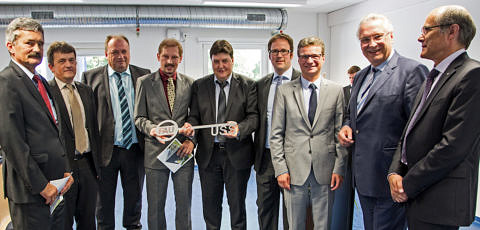New laboratory building at the Biotechnology Research Centre

With the new laboratory building at the Biotechnology Research Centre at Ulrich-Schalk-Straße, three chairs at FAU are moving to ultramodern premises: the new location offers 882 square metres of research space for teams from Medical Biotechnology, Biomaterials and Endogenous Geodynamics. For the inauguration on 8 July, FAU Vice President Prof. Dr. Günter Leugering welcomed Bernd Sibler, member of the Bavarian parliament and State Secretary at the Bavarian State Ministry of Education, Science and the Arts, Joachim Herrmann, member of the Bavarian parliament and Bavarian Minister of the Interior for Construction and Transport, Dr . Florian Janik, Mayor of Erlangen, Prof. Dr. Peter Greil, Dean of the Faculty of Engineering, Prof. Dr. Wolfgang Kießling, Vice Dean of the Faculty of Science, Planning Director Dieter Maußner from the State Construction Office of Erlangen-Nuremberg and numerous guests.

‘With the new laboratory building, FAU has succeeded once again, with the support of the Free State of Bavaria, in providing excellent infrastructure for three research fields of international visibility. The building is a true paradise of the latest technology: one of Europe’s most modern cleanroom and mass spectrometer laboratories, with a configuration unique in Germany, multi-photon microscopes and first-class modern processing and characterization equipment for biomaterials are all here,’ said FAU Vice President Günter Leugering in his welcome speech. He was especially pleased that appointments were confirmed for all three chairs.
State Secretary Bernd Sibler remarked: ‘The Free State of Bavaria has made a strong investment in the future of Bavaria as an important location for science and research. The new laboratory building has excellent facilities: Biomaterials, Medical Biotechnology and Endogenous Geodynamics will have ideal conditions for deepening their research. This will help ensure that FAU will continue to be regarded highly in national and international competition.’
‘The new research centre strengthens the university location in one of the key technologies of the 21st century,’ added State Minister Herrmann. ‘The 12.4 million euro investment made by the Free State of Bavaria has excellent value here.’
Before the ceremonial key handover by Planning Director Dieter Maußner, the university pastors Eva Simoneit-Wanke and Harald Kreßmann gave an ecumenical blessing.
The new laboratory building is an important part of the interdisciplinary biotechnology research centre on the 9000 square metre site at Ulrich-Schalk-Straße. A special feature of the research centre in addition to the ultramodern mass spectrometer laboratory is its four metal-free cleanrooms. GeoZentrum Nordbayern now has one of the most modern mass spectrometer and cleanroom laboratories in Europe – also the largest in Bavaria – for dating rocks and determining mixing processes in molten rock or water. ‘Such studies make an important contribution to understanding the evolution of earth and life itself. We can learn more about the formation of molten rock in the earth, the development of volcanoes and the earth’s crust, the formation of ore deposits and the chemical exchange processes between the earth’s interior, the ocean and the atmosphere,’ explains Prof. Dr. Wolfgang Kiessling, Vice Dean of the Faculty of Sciences.
Other laboratories for materials and biotechnology and genetic laboratories with the security levels S1 and S2 – all in the highest cleanroom classes – complement the laboratory environment, in which the Free State of Bavaria has invested 12.4 million euros for new construction and renovation of the existing building. Here, Medical Biotechnology focus on the interface between engineering and life sciences in areas such as improving cellular diagnosis or the manipulation of cells and tissues. ‘Mechanisms of structure-function relationships in biological tissues and their changes, for example in tissue damage, genetic approaches to understanding malaria parasites and their control or developing automated robotic systems for the investigation of contractile tissue in the skeletal or heart muscle, are just some aspects that will be examined here,’ said Prof. Dr. Peter Greil, Dean of the Faculty of Engineering.
He also emphasised that the configuration of the multi-photon microscopes in the laboratory was unique in Germany. ‘At Materials Science (Biomaterials), we are doing research at the highest international level into nanostructured biomaterials for use in medical implants, for structures in targeted tissue engineering, for antibacterial surface coatings and for the controlled release of specific substances through implants,’ he said. This research is orientated towards the development of organ and tissue-like three-dimensional structures for regenerative medicine and cancer research.